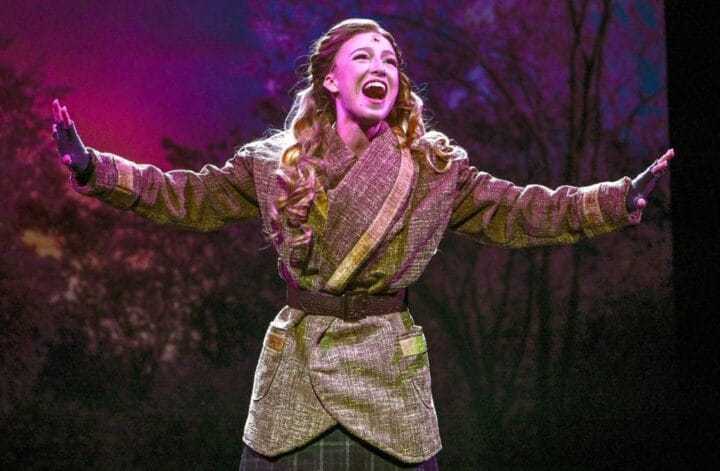Oh Anastasia – the last, lost princess of Imperial Russia’s Romanov dynasty. Is her story a legend?… A fairy tale?… A wish?… A dream?
When times are tough we tend to romanticize a happier past. And if that past serves as inspiration to create beautiful art… Why, so much the better! The mythical survival of Grand Duchess Anastasia Nikolaevna – youngest daughter of Tsar Nicholas II and Tsarina Alexandra’s five children (after Bolsheviks brutally executed the royal family during the Russian Revolution of 1917) – has been celebrated by dramatic presentations on stage, on screen, via animation, musicals … even ballet. While embellished in many ways, the core story of a spunky young woman’s unflagging spirit of survival and search for self-discovery continues to inspire our souls and warm our hearts.
I’ve seen some of the above versions – always with pleasure. Maybe I’m biased and/or still riding a high from Sunday’s matinee, but I certainly wasn’t alone in feeling that Slow Burn Theatre Company’s presentation of ANASTASIA: THE MUSICAL, playing through January 5, achieved a pinnacle of Anastasia-story-telling and musical perfection. That special Slow Burn musical touch, once again, excelled at immersing us in an alternate universe by embracing the splendor of old Imperial Russia. As well as the cold and scheming streets of St. Petersburg turned Leningrad, backed by an uneasy love story between a couple and between generations. They also managed to capture the romance and frenzy of Jazz Age Paris.
Admittedly, this musical stands on the shoulders of some great creators. It was inspired by Guy Bolton’s adaptation of the play by Marcelle Maurette and then, of course, the popular 1997 20th Century Fox animation from which it kept six songs (and added 16).

The live musical is actually fairly recent. An audience favorite since premiering on Broadway in 2017, it continues to tour worldwide. Anastasia: The Musical boasts the Tony-nominated team of playwright Terrence McNally with a score by Stephen Flaherty (music) and Lynn Ahrens (lyrics). For our production, Slow Burn’s Carbonell Award-winning artistic director Patrick Fitzwater once again serves as director. He’s joined by notable locals Cat Pagano as choreographer and Ryan Crout as music director/ensemble member. Everyone in the production team is first rate – and I’ll mention their special talents in a bit – but first must give a shout out to the absolutely unrivaled vocal and dance talent of every single member of the cast. And, yes, they were given great material to work with. Still, just about every number was a show stopper, met with enthusiastic applause!
Let’s begin with the lead. The back screen date flashes “1927” when we first meet young-adult “Anya” (really Princess Anastasia who suffers from amnesia, night terrors, and is freaked out by loud noises). When Anya sings her opening solo, “In My Dreams,” we are dumbstruck by the incredible power and beauty of her voice. Mikayla Cohen, as Anya/Anastasia, gives a true star performance throughout. Cohen is described in the program as “an ‘upcoming’ singer, songwriter, and actor.” I’m yet to check out her original music, but as for her singing and acting, this show should definitely launch the South Florida-bred and internationally performing professional to “having arrived”!
Snippets of Anya’s dreams are portrayed by ghostly shadows of her family amidst Grand Ballroom dancers that, at times, emerge in person, resurrecting the musical’s opening waltz, “The Last Dance of the Romanovs.” The magic of that moment is palpable thanks to Rick Pena’s glittering diamond tiaras and lavish costume designs, topped by Fitzwater-styled wigs (he’s also credited for prop design). Pena’s costuming never ceases to impress; I also adored his subsequent Roaring Twenties’ fringed and sparkly flapper dresses.
A magical stage set that could instantly switch from chandeliered palace, to mean streets to Parisian cafe and Ballet is due to the creative vision of scenic designer Nikolas Serrano. I especially loved the bright open layout of his revolving railroad car, enhanced by Eric Norbury’s lighting design (there and throughout the show) along with the many historic and moving (physically and emotionally) scenery projection designs by Kacey Koploff.
The Prologue to Act I ends with horrific fiery blasts, seen and heard through high, smoke-filled windows. Trigger alert (Anastasia could have used this, but maybe some audience members as well): There will be loud explosions and gunshots. Serious sound effects heighten the drama, along with music to convey the mood, thanks to Dan Donato’s masterly sound design. And we can safely (though it doesn’t look that way for the attacking ruffians) applaud Anya’s street-savvy fight skills thanks to Lee Soroko’s fight choreography expertise and fight captain Sarah Sun Park.
Anya’s hidden talents never cease to amaze. Her character is based on the real Princess Anastasia whose historical record up till age 17 describes her as fiercely independent (least-interested in royal protocol), witty, bright, vivacious and mischievous (often labeled “a troublemaker” as a child), but also loving and kind. She was prone to devising funny skits to entertain her family and lift their spirits during dire times. When two con men convince Anya to play the role of Anastasia to win the reward offered by the Dowager Empress (the princess’s grandmother) for her safe return, she sees it as her ticket to Paris. A place she feels in her bones she must get to – though she has no idea why.
But we do. The Prologue features the show’s iconic song, “Once Upon a December,” sung by Little Anastasia (Blaire DiMisa) and much-in-demand local star Laura Turnbull, now only recognizable as the Dowager Empress! She gifts her five-year-old granddaughter a special music box to remember her by as she takes off to Paris but promises they’ll be reunited there someday. (The music box survives some travels as well, but fate eventually returns it to its rightful owner. Fortuitous, as it comes to provide an essential link to Anastasia’s past and proof of her identity.)
Years later, teen Anastasia tries, but fails, to retrieve her grandmother’s precious gift when the revolution comes knocking at their door. She only gets it back after commoner/con man Dmitri buys it from a Leningrad street vendor for two cans of beans, then gives it to her as a gift, admitting it’s broken and won’t open. He’s stunned when Anya instantly unlocks the mechanism, unleashing its lovely music and tiny circling dancers.
We first meet that con man and his partner in crime in the musical number, “A Rumor in St. Petersburg” by Dmitry, Vlad and Ensemble. Dmitry is a tough but intrinsically kind-hearted young man, an orphan who raised himself on the streets of what he insists on calling St. Petersburg and to heck with “the people’s Leningrad.” His take on the Revolution: “Same empty stomach. Thank goodness for the gossip that gets us through the day.” The latest rumor to stir up the populace is hope that Princess Anastasia is alive. “They say the royal grandmother will pay a royal sum” for her return.
Jarod Bakum not only plays Dmitry, he is Dmitry in all his complexity – from naive royal worship to defiant self-sufficiency. Making his Slow Burn debut in this major role, Brooklyn-based (but widely traveled) Bakum aces all his singing, dancing, and acting challenges.





